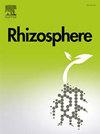Physiological and metabolic effects of a transposon-mediated mutation in the glutamate synthase gene, gltB, of plant-beneficial, cytokinin-producing Pseudomonas hormoni G20-18T
IF 3.5
3区 生物学
Q1 PLANT SCIENCES
引用次数: 0
Abstract
Pseudomonas species are well-studied Gram-negative bacteria involved in plant-microbe interactions, particularly in the rhizosphere and phyllosphere, where they enhance plant growth and resilience under stress. A key trait of these bacteria is the production of plant hormones, which help plants resist biotic and abiotic stresses. Pseudomonas hormoni G20-18T (previously denoted P. fluorescens G20-18) is a beneficial bacterium that produces cytokinins (CKs), improving plant resistance to pathogens and drought. A mutant strain, CNT1, shows reduced CK levels, but the mechanisms behind this reduction and its effects on plant interactions are not fully understood. Genome sequencing of the mutant revealed insertion of a transposon in the glutamate synthase, large subunit gene (gltB). This mutation led to reduced growth, survival, and biofilm formation at 25 °C and pH 5.0. The carbon substrate utilization pattern also differed from the wild type, and applying exogenous CKs failed to restore the wild type effects, suggesting a broader impact on metabolism. Untargeted metabolomics confirmed the global influence of the gltB mutation, also affecting CK and auxin expression. These findings highlight the significant role of the gltB gene in regulating bacterial physiology and plant-beneficial interactions.
对植物有益的产生细胞分裂素的激素假单胞菌G20-18T的谷氨酸合成酶基因(gltB)转座子介导突变的生理和代谢影响
假单胞菌是一种被充分研究的革兰氏阴性细菌,参与植物与微生物的相互作用,特别是在根际和根层圈,它们促进植物生长和在逆境下的恢复能力。这些细菌的一个关键特性是产生植物激素,帮助植物抵抗生物和非生物胁迫。激素假单胞菌G20-18T(以前称为荧光假单胞菌G20-18)是一种产生细胞分裂素(CKs)的有益细菌,可提高植物对病原体和干旱的抗性。突变株CNT1显示CK水平降低,但这种降低背后的机制及其对植物相互作用的影响尚不完全清楚。突变体的基因组测序显示在谷氨酸合成酶大亚基基因(gltB)中插入一个转座子。在25°C和pH 5.0条件下,该突变导致生长、存活和生物膜形成降低。碳底物利用模式也与野生型不同,外源ck未能恢复野生型的效应,表明对代谢的影响更广泛。非靶向代谢组学证实了gltB突变的全球影响,也影响CK和生长素的表达。这些发现强调了gltB基因在调节细菌生理和植物有益相互作用中的重要作用。
本文章由计算机程序翻译,如有差异,请以英文原文为准。
求助全文
约1分钟内获得全文
求助全文
来源期刊

Rhizosphere
Agricultural and Biological Sciences-Agronomy and Crop Science
CiteScore
5.70
自引率
8.10%
发文量
155
审稿时长
29 days
期刊介绍:
Rhizosphere aims to advance the frontier of our understanding of plant-soil interactions. Rhizosphere is a multidisciplinary journal that publishes research on the interactions between plant roots, soil organisms, nutrients, and water. Except carbon fixation by photosynthesis, plants obtain all other elements primarily from soil through roots.
We are beginning to understand how communications at the rhizosphere, with soil organisms and other plant species, affect root exudates and nutrient uptake. This rapidly evolving subject utilizes molecular biology and genomic tools, food web or community structure manipulations, high performance liquid chromatography, isotopic analysis, diverse spectroscopic analytics, tomography and other microscopy, complex statistical and modeling tools.
 求助内容:
求助内容: 应助结果提醒方式:
应助结果提醒方式:


